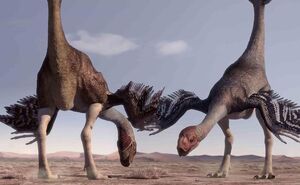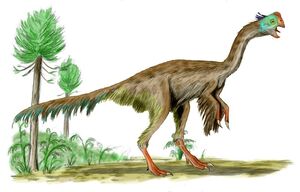
| |
| Scientific name | Gigantoraptor erlianensis |
| Home era | Cretaceous |
| Creature type | Theropod Dinosaur |
| Deaths caused | 1 |
| Appearances | Episode 1.5 |
Gigantoraptor was one of the largest feathered animals of all time
In Primeval Adventure Series[]
A Gigantoraptor came through an anomaly at a school. It killed a teacher called Mrs Weden and the team thought it was the creature that ate the teacher that came down to the canteen for a snack. An Alectrosaurus came and then the Gigantoraptor had a fight with it where it got transported back safely through the anomaly along with the Alectrosaurus pack later on. (Episode 1.5)
Facts[]
In 2005, a Chinese palaeontologist filming sauropod bones in Mongolia came across an unidentified thigh bone. It was a fortunate discovery. The bone belonged to a creature that may have been eight metres in length and more than two tons in weight. Gigantoraptor, as it was subsequently named, is the largest feathered dinosaur discovered to date. It is 35 times bigger than the next largest species of Oviraptorid. The toothless skull of this bird-like dinosaur was more than half a metre long with a horny beak. It had long hind legs and large claws and would have been fast enough to outrun most predators around 70 million years ago. It seems certain that Gigantoraptor's feathers were for display rather than for flight or insulation.

Life restoration
Despite its scary name, it's important to realize that Gigantoraptor wasn't technically a true raptor, like Deinonychus, Velociraptor or the equally huge Utahraptor. Rather, this large, feathered theropod was a close relative of Oviraptor, and the largest such "dino-bird" yet discovered. Gigantoraptor was "diagnosed" based on a single, incomplete skeleton found in Mongolia in 2005, so further discoveries may shed some much-needed light on its lifestyle (such as whether it contented itself with a herbivorous diet, like other oviraptors, or occasionally supplemented its leafy greens by hunting smaller dinosaurs).